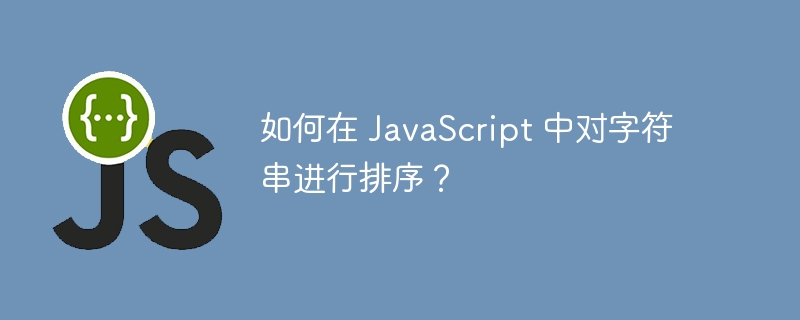如何在 JavaScript 中对字符串进行排序?

排序字符串是将字符串按字典顺序或字母顺序排列。使用 JavaScript 开发应用程序时通常会对字符串数组进行排序。在本教程中,我们将学习在 JavaScript 中对字符串进行排序。
例如,如果您从 API 获取一些数据并希望按排序顺序显示该数据,则字符串排序在这里非常有用。
在这里,我们将学习使用内置方法和各种简单的方法对字符串进行排序。
使用sort()方法对字符串进行排序
在 JavaScript 中,sort() 是我们可以对数组使用的内置方法。一般来说,在其他编程语言中,sort()方法默认对数值进行排序。但是,JavaScript 将数字转换为字符串并按字母顺序对它们进行排序。
因此,我们可以使用 JavaScript 的 sort() 方法而不使用比较器函数来对字符串数组进行排序。
语法
用户可以按照以下语法使用 JavaScript 的 sort() 方法对字符串进行排序。
Strings.sort();
在上面的语法中,我们使用字符串数组作为引用和 sort() 方法。
示例 1
在此示例中,我们定义了字符串数组并使用一些字符串值对其进行初始化。之后,我们以数组为引用并执行数组的 sort() 方法。用户可以观察输出结果,数组中的所有字符串均按字母顺序排序。
<html>
<body>
<h2>Using the <i>sort() method</i> to sort an array of strings in JavaScript.</h2>
<div id = "output"> </div>
<script>
let output = document.getElementById('output');
let strings = ["Hi", "JavaScript", "TypeScript", "C", "CPP", "Python", "Java", "HTML", "CSS"];
output.innerHTML += "The original string array is " + strings + "<br/>";
strings.sort();
output.innerHTML += "The sorted string array is " + strings + "<br/>";
</script>
</body>
</html>
使用for循环对字符串进行排序(冒泡排序算法)
对字符串进行排序的简单方法是使用 for 循环。我们可以使用两个嵌套的 for 循环将每个字符串与所有其他字符串进行比较,并按字母顺序对它们进行排序。另外,我们可以说它是一种冒泡排序算法。
语法
用户可以按照下面的语法使用冒泡排序算法对字符串按字母顺序进行排序。
for (let a = 0; a < strings.length; a++) {
for (let b = a + 1; b < strings.length; b++) {
if (strings[a] > strings[b]) {
// swap strings at index a and index b
}
}
}
在上面的语法中,我们使用了两个嵌套的 for 循环并迭代字符串数组。此外,我们还比较两个字符串值,并基于此交换字符串。
算法
第 1 步 - 创建字符串数组。
第 2 步 - 使用 for 循环并从第 0 个索引开始迭代字符串数组。
步骤 3 - 在 for 循环中,使用另一个 for 循环,并开始迭代第 a+1 个索引,此时 a 是第一个 for 循环的迭代指针。
第 4 步 - 现在,比较 ath 和 bth 索引处的字符串。
步骤 5 - 如果第 ath 索引处的字符串的字母顺序大于第 b 个索引处的字符串,则交换两个字符串。
第 6 步 - 完成两个 for 循环的所有迭代,以按排序顺序获取所有字符串。
示例2(考虑字符串字符的大小写)
在下面的示例中,我们实现了冒泡排序算法来对字符串数组进行排序。下面的输出向我们展示了冒泡排序算法对所有字符串进行排序,其中大写字母在小写字母之前,因为在字符串比较中大写字母比小写字母具有更高的优先级。
<html>
<body>
<h2>Using the <i> bubble sort algorithm </i> to sort an array of strings in JavaScript.</h2>
<div id = "output"> </div>
<script>
let output = document.getElementById('output');
let strings = ["car", "Bike", "truck", "cycle", "Tempo", "cart", "abcd", "string"];
output.innerHTML += "The original string array is " + strings + "<br/>";
for (let a = 0; a < strings.length; a++) {
for (let b = a + 1; b < strings.length; b++) {
if (strings[a] > strings[b]) {
let tempString = strings[a];
strings[a] = strings[b];
strings[b] = tempString;
}
}
}
output.innerHTML += "The sorted string array is " + strings + "<br/>";
</script>
</body>
</html>
示例3(忽略字符串字符的大小写)
在此示例中,我们实现了冒泡排序算法来对字符串进行排序,但我们比较的是小写字符串。在上面的示例中,我们根据字母顺序对字符串进行排序,并对大写字母进行优先排序。但在这里,我们忽略字符串字符的大小写并比较字符串。
<html>
<body>
<h2>Using the <i> bubble sort algorithm </i> to sort an array of strings in JavaScript.</h2>
<div id = "output"> </div>
<button onclick = "sortStrings()"> Sort Strings </button>
<script>
let output = document.getElementById('output');
let strings = ["ab", "Bc", "AB", "AC", "cd", "ds", "ds", "erere", "DS"];
output.innerHTML += "The original strings are " + strings + "<br/>";
function sortStrings() {
function swap(index1, index2) {
let tempString = strings[index1];
strings[index1] = strings[index2];
strings[index2] = tempString;
}
for (let a = 0; a < strings.length; a++) {
for (let b = a + 1; b < strings.length; b++) {
if (strings[a].toLowerCase() > strings[b].toLowerCase()) {
swap(a, b)
}
}
}
output.innerHTML += "The sorted strings are " + strings + "<br/>";
}
</script>
</body>
</html>
我们在本教程中学习了对多个字符串进行排序。在第一种方法中,我们使用了 sort() 方法,因为它始终按字母顺序对字符串进行排序。在第二种方法中,我们实现了冒泡排序算法来对字符串进行排序,但我们可以对其进行优化以提高时间效率。此外,我们可以使用其他算法(例如合并排序)来提高排序算法的时间和空间效率。
以上是如何在 JavaScript 中对字符串进行排序?的详细内容。更多信息请关注PHP中文网其他相关文章!

热AI工具

Undresser.AI Undress
人工智能驱动的应用程序,用于创建逼真的裸体照片

AI Clothes Remover
用于从照片中去除衣服的在线人工智能工具。

Undress AI Tool
免费脱衣服图片

Clothoff.io
AI脱衣机

AI Hentai Generator
免费生成ai无尽的。

热门文章

热工具

记事本++7.3.1
好用且免费的代码编辑器

SublimeText3汉化版
中文版,非常好用

禅工作室 13.0.1
功能强大的PHP集成开发环境

Dreamweaver CS6
视觉化网页开发工具

SublimeText3 Mac版
神级代码编辑软件(SublimeText3)

热门话题
 如何在浏览器中优化JavaScript代码以进行性能?
Mar 18, 2025 pm 03:14 PM
如何在浏览器中优化JavaScript代码以进行性能?
Mar 18, 2025 pm 03:14 PM
本文讨论了在浏览器中优化JavaScript性能的策略,重点是减少执行时间并最大程度地减少对页面负载速度的影响。
 如何使用浏览器开发人员工具有效调试JavaScript代码?
Mar 18, 2025 pm 03:16 PM
如何使用浏览器开发人员工具有效调试JavaScript代码?
Mar 18, 2025 pm 03:16 PM
本文讨论了使用浏览器开发人员工具的有效JavaScript调试,专注于设置断点,使用控制台和分析性能。
 如何使用源地图调试缩小JavaScript代码?
Mar 18, 2025 pm 03:17 PM
如何使用源地图调试缩小JavaScript代码?
Mar 18, 2025 pm 03:17 PM
本文说明了如何使用源地图通过将其映射回原始代码来调试JAVASCRIPT。它讨论了启用源地图,设置断点以及使用Chrome DevTools和WebPack之类的工具。
 开始使用Chart.js:PIE,DONUT和BUBBLE图表
Mar 15, 2025 am 09:19 AM
开始使用Chart.js:PIE,DONUT和BUBBLE图表
Mar 15, 2025 am 09:19 AM
本教程将介绍如何使用 Chart.js 创建饼图、环形图和气泡图。此前,我们已学习了 Chart.js 的四种图表类型:折线图和条形图(教程二),以及雷达图和极地区域图(教程三)。 创建饼图和环形图 饼图和环形图非常适合展示某个整体被划分为不同部分的比例。例如,可以使用饼图展示野生动物园中雄狮、雌狮和幼狮的百分比,或不同候选人在选举中获得的投票百分比。 饼图仅适用于比较单个参数或数据集。需要注意的是,饼图无法绘制值为零的实体,因为饼图中扇形的角度取决于数据点的数值大小。这意味着任何占比为零的实体
 谁得到更多的Python或JavaScript?
Apr 04, 2025 am 12:09 AM
谁得到更多的Python或JavaScript?
Apr 04, 2025 am 12:09 AM
Python和JavaScript开发者的薪资没有绝对的高低,具体取决于技能和行业需求。1.Python在数据科学和机器学习领域可能薪资更高。2.JavaScript在前端和全栈开发中需求大,薪资也可观。3.影响因素包括经验、地理位置、公司规模和特定技能。
 初学者的打字稿,第2部分:基本数据类型
Mar 19, 2025 am 09:10 AM
初学者的打字稿,第2部分:基本数据类型
Mar 19, 2025 am 09:10 AM
掌握了入门级TypeScript教程后,您应该能够在支持TypeScript的IDE中编写自己的代码,并将其编译成JavaScript。本教程将深入探讨TypeScript中各种数据类型。 JavaScript拥有七种数据类型:Null、Undefined、Boolean、Number、String、Symbol(ES6引入)和Object。TypeScript在此基础上定义了更多类型,本教程将详细介绍所有这些类型。 Null数据类型 与JavaScript一样,TypeScript中的null








